The document is a tutorial on Torch7, covering installation, basic examples, tensor systems, notable packages like nn, optim, and dp, along with references and data handling techniques. It explains fundamental operations, tensor manipulation, neural network modeling, optimization methods, and command-line argument handling for various preprocessing and data sources. Additionally, it compares Torch7 with Theano, highlighting the ease of coding in C/CUDA as a reason for preference.
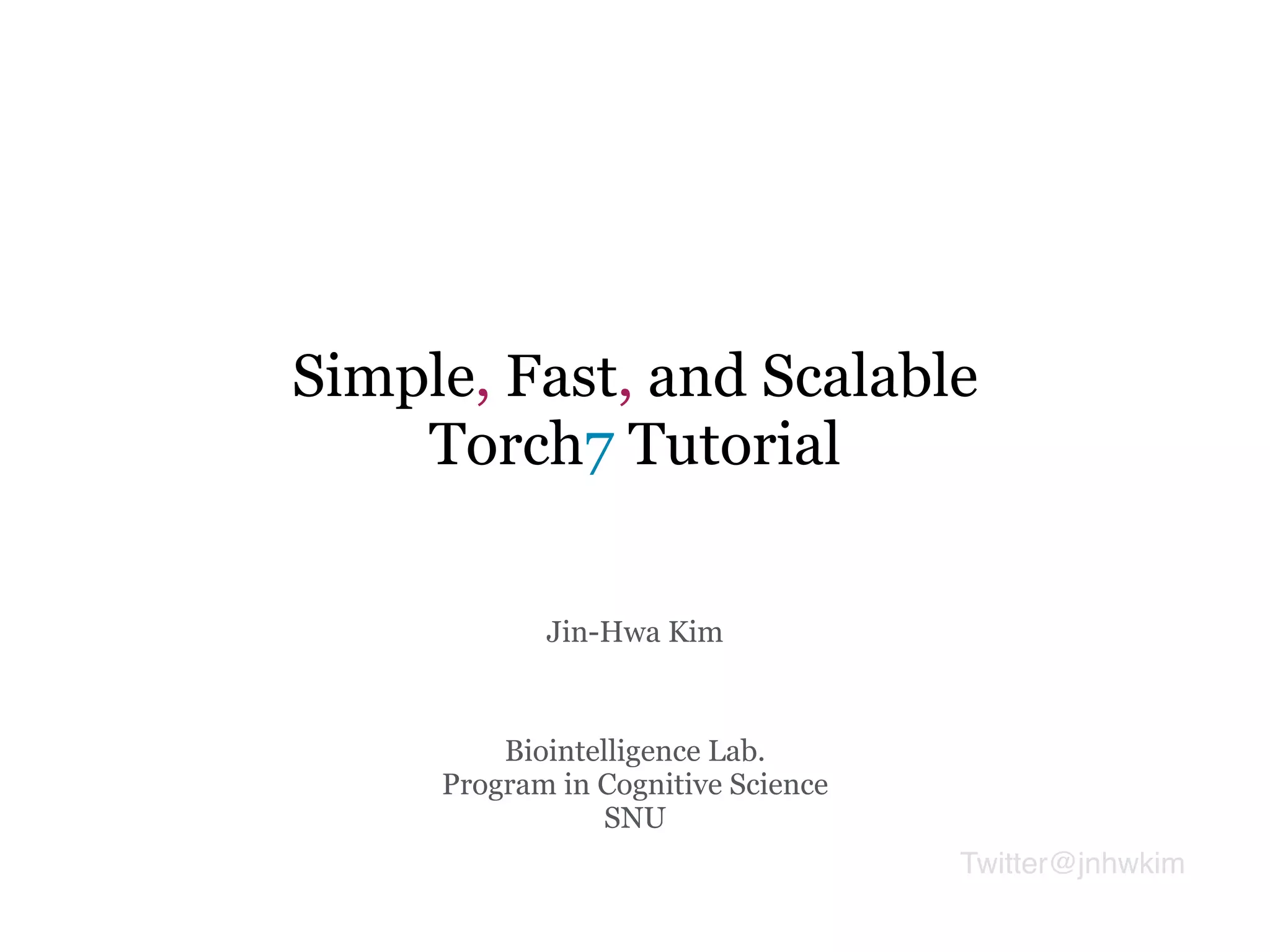
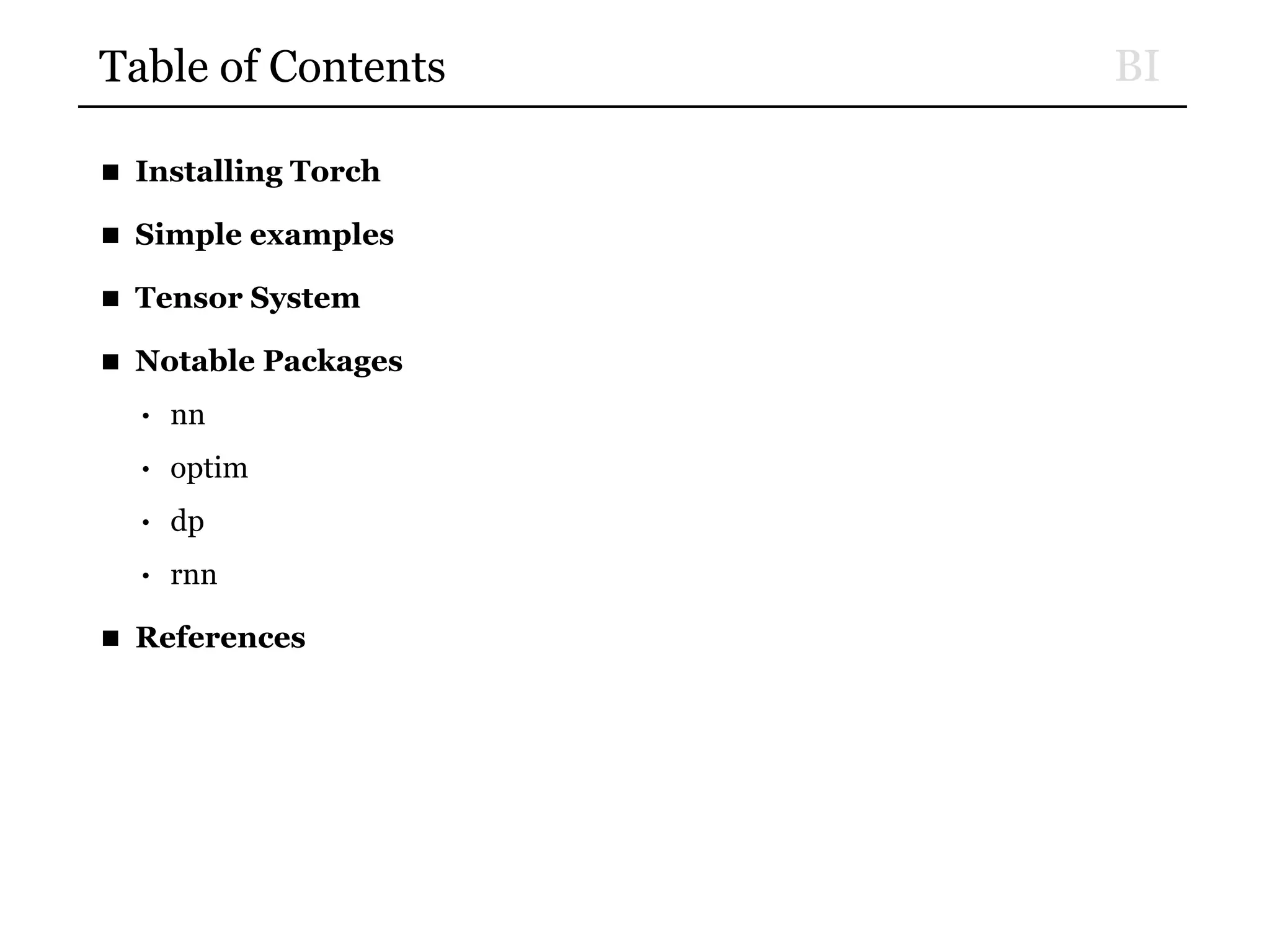
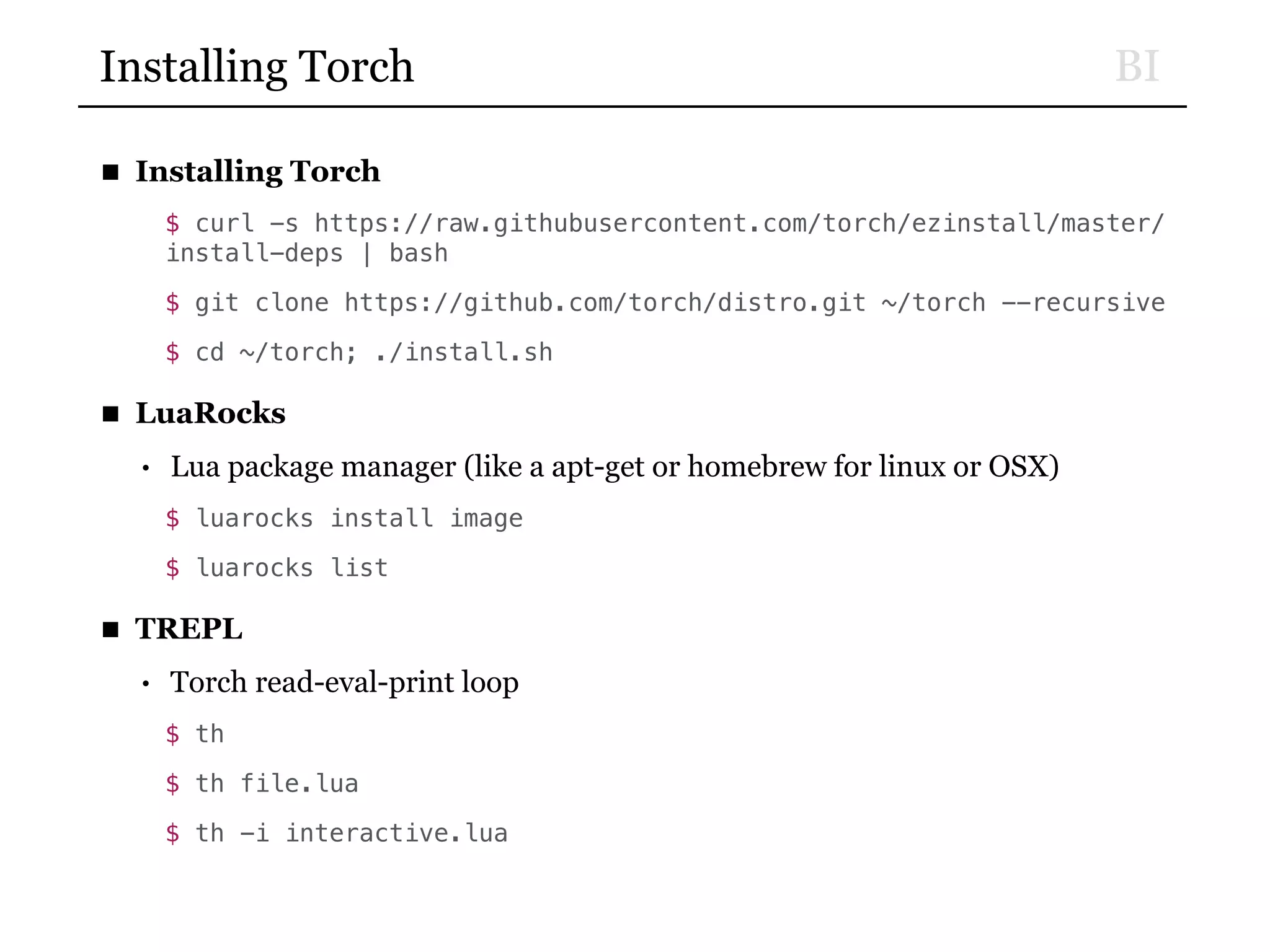
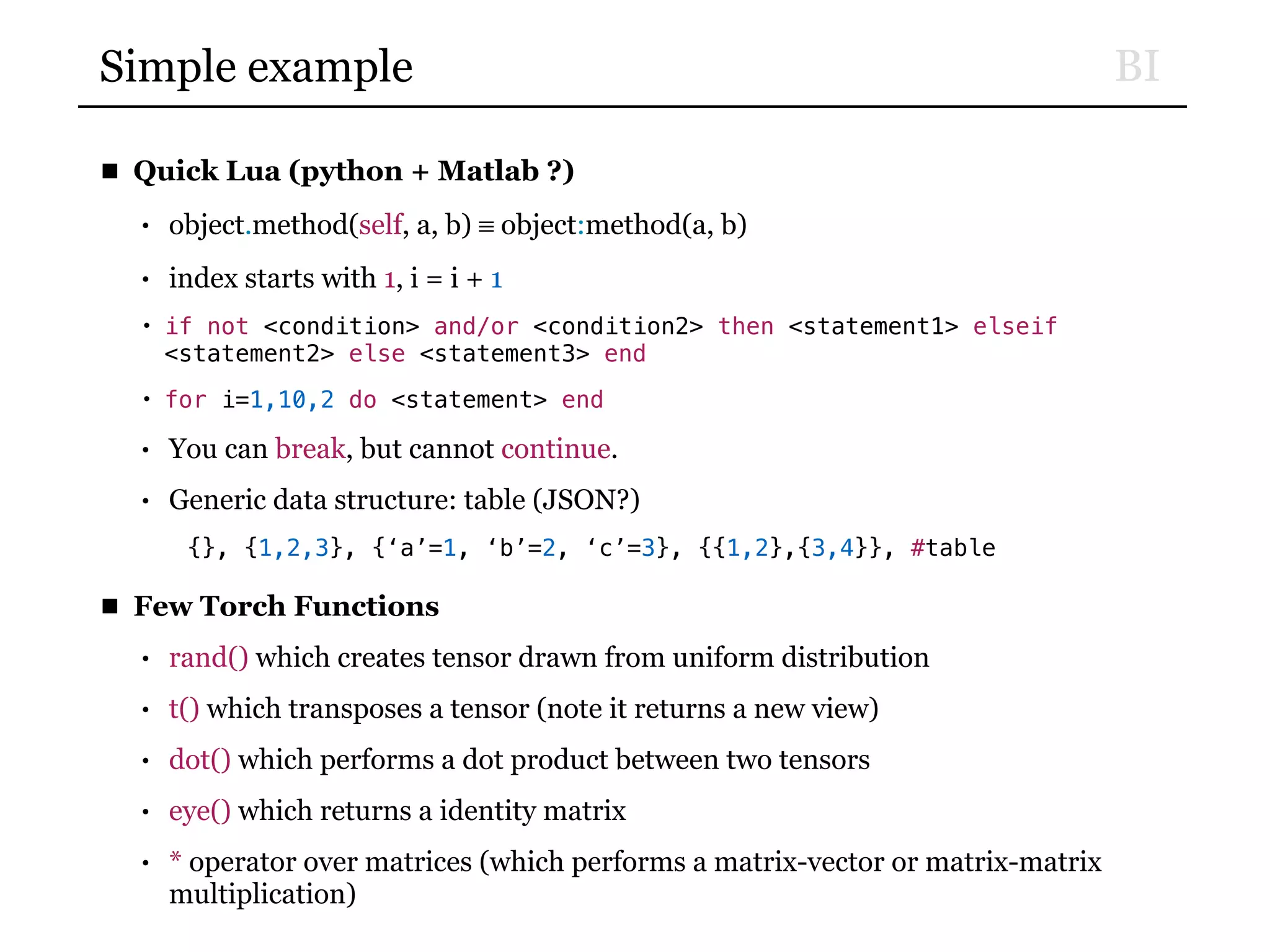
![BITensor System (1/6)
■ Fundamental data class, Tensor
• Handling numeric data
• Serializable (If you want, can save as a file.)
• Tensor interprets a chunk of memory as having dimensions.
■ Size
> x:nDimension()
6
> x:size() —- use x:size(dim) for a specific dimension
4
5
6
2
7
3
[torch.LongStorage of size 6]
■ Access
> x[3][4][5]](https://image.slidesharecdn.com/simplefastandscalabletorch7tutorial-150924024306-lva1-app6891/75/Simple-fast-and-scalable-torch7-tutorial-5-2048.jpg)
![BITensor System (2/6)
■ Memory Contiguous
• It’s a C style, not Fortran.
x = torch.Tensor(4,5)
i = 0
x:apply(function()
i = i + 1
return i
end)
> x
1 2 3 4 5
6 7 8 9 10
11 12 13 14 15
16 17 18 19 20
[torch.DoubleTensor of dimension 4x5]
> x:stride()
5
1 -- element in the last dimension are contiguous!
[torch.LongStorage of size 2]](https://image.slidesharecdn.com/simplefastandscalabletorch7tutorial-150924024306-lva1-app6891/75/Simple-fast-and-scalable-torch7-tutorial-6-2048.jpg)
![BITensor System (3/6)
■ Tensor Types
ByteTensor -- contains unsigned chars
CharTensor -- contains signed chars
ShortTensor -- contains shorts
IntTensor -- contains ints
FloatTensor -- contains floats
DoubleTensor -- contains doubles
■ Most numeric operations are implemented only for FloatTensor and
DoubleTensor (e.g. torch.histc()).
> torch.histc(torch.IntTensor(5))
[string "_RESULT={torch.histc(a)}"]:1: torch.IntTensor does not implement the
torch.histc() function
stack traceback:
[C]: in function 'histc'
[string "_RESULT={torch.histc(a)}"]:1: in main chunk
[C]: in function 'xpcall'
/Users/Calvin/torch/install/share/lua/5.1/trepl/init.lua:630: in function 'repl'
...lvin/torch/install/lib/luarocks/rocks/trepl/scm-1/bin/th:185: in main chunk
[C]: at 0x010e9422f0
torch.setdefaulttensortype(‘torch.FloatTensor')
a = torch.Tensor()
a:type()
a:size(dim)](https://image.slidesharecdn.com/simplefastandscalabletorch7tutorial-150924024306-lva1-app6891/75/Simple-fast-and-scalable-torch7-tutorial-7-2048.jpg)
![BITensor System (4/6)
■ Querying elements
> x[2][3] -- returns row 2, column 3
6
> x[{2,3}] -- another way to return row 2, column 3
6
> x[torch.LongStorage{2,3}] -- yet another way to return row 2, column 3
6
> x[torch.le(x,3)] -- torch.le returns a ByteTensor that acts as a mask
1
2
3
[torch.DoubleTensor of dimension 3]
■ Extracting sub-tensors
[self] narrow(dim, index, size)
[Tensor] sub(dim1s, dim1e ... [, dim4s [, dim4e]])
[Tensor] select(dim, index)
or just using operator [] …](https://image.slidesharecdn.com/simplefastandscalabletorch7tutorial-150924024306-lva1-app6891/75/Simple-fast-and-scalable-torch7-tutorial-8-2048.jpg)
![BITensor System (5/6)
■ Indexing operator []
x = torch.Tensor(5, 6):zero()
> x
0 0 0 0 0 0
0 0 0 0 0 0
0 0 0 0 0 0
0 0 0 0 0 0
0 0 0 0 0 0
[torch.DoubleTensor of dimension 5x6]
x[{ 1,3 }] = 1 -- sets element at
> x (i=1,j=3) to 1
0 0 1 0 0 0
0 0 0 0 0 0
0 0 0 0 0 0
0 0 0 0 0 0
0 0 0 0 0 0
[torch.DoubleTensor of dimension 5x6]
x[{ 2,{2,4} }] = 2 -- sets a slice
> x of 3 elements to 2
0 0 1 0 0 0
0 2 2 2 0 0
0 0 0 0 0 0
0 0 0 0 0 0
0 0 0 0 0 0
[torch.DoubleTensor of dimension 5x6]
x[{ {},4 }] = -1 -- sets the full 4th column to -1
> x
0 0 1 -1 0 0
0 2 2 -1 0 0
0 0 0 -1 0 0
0 0 0 -1 0 0
0 0 0 -1 0 0
[torch.DoubleTensor of dimension 5x6]
x[{ {},2 }] = torch.range(1,5) -- copy a 1D tensor
> x to a slice of x
0 1 1 -1 0 0
0 2 2 -1 0 0
0 3 0 -1 0 0
0 4 0 -1 0 0
0 5 0 -1 0 0
[torch.DoubleTensor of dimension 5x6]
x[torch.lt(x,0)] = -2 -- sets all negative elements
> x to -2 via a bytetensor mask
0 1 1 -2 0 0
0 2 2 -2 0 0
0 3 0 -2 0 0
0 4 0 -2 0 0
0 5 0 -2 0 0
[torch.DoubleTensor of dimension 5x6]](https://image.slidesharecdn.com/simplefastandscalabletorch7tutorial-150924024306-lva1-app6891/75/Simple-fast-and-scalable-torch7-tutorial-9-2048.jpg)
![BITensor System (6/6)
■ And so on …
• See how many functions are the same you’ve used in Matlab!
⋮
[Tensor] gather(dim, index)
[LongTensor] nonzero(tensor)
[result] expand([result,] sizes)
[Tensor] repeatTensor([result,] sizes)
[Tensor] squeeze([dim])
[Tensor] transpose(dim1, dim2)
[Tensor] permute(dim1, dim2, ..., dimn)
[Tensor] unfold(dim, size, step)
⋮](https://image.slidesharecdn.com/simplefastandscalabletorch7tutorial-150924024306-lva1-app6891/75/Simple-fast-and-scalable-torch7-tutorial-10-2048.jpg)
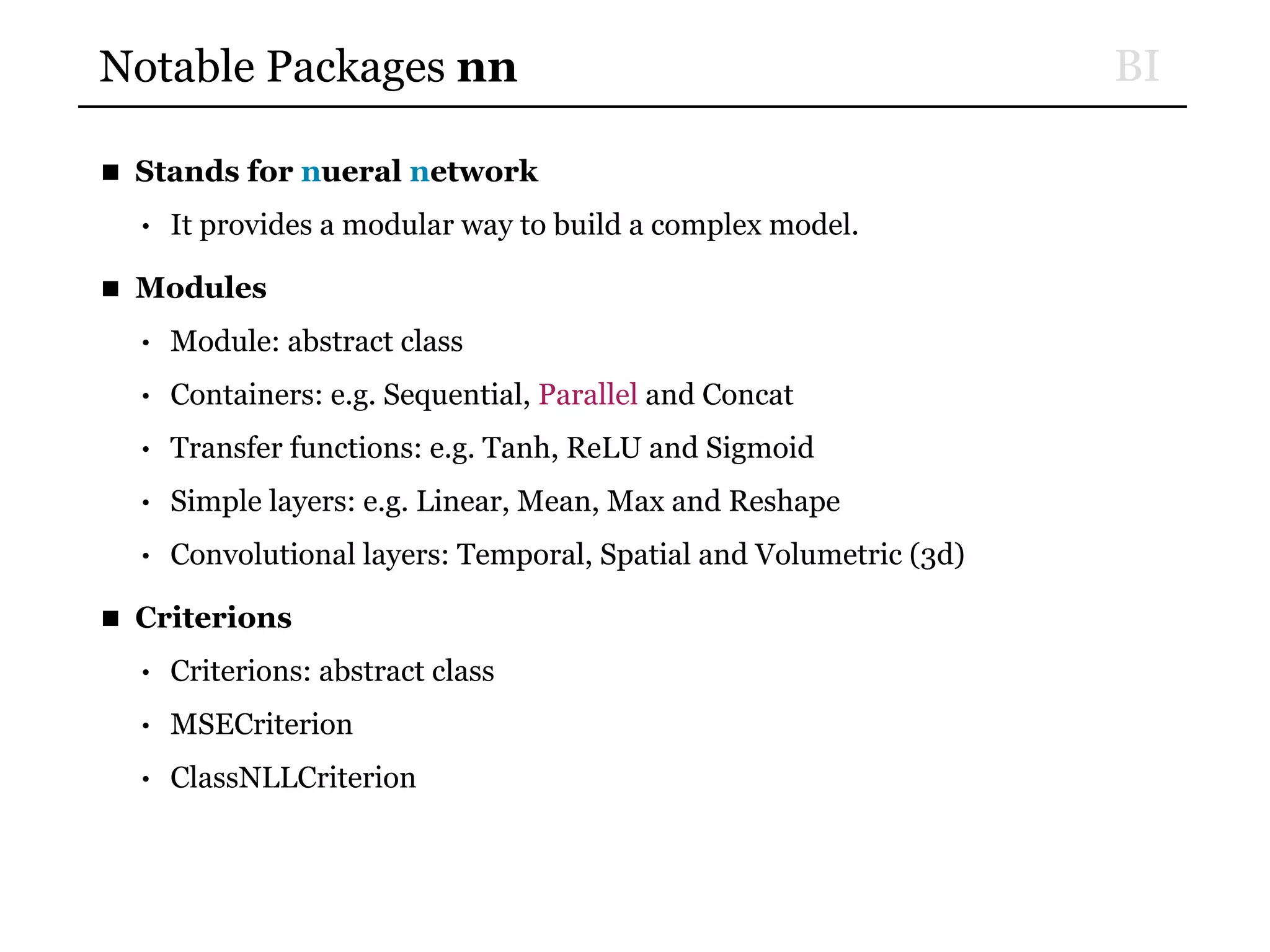
![BINotable Packages nn
■ nn example of manual training (though you gonna not using this)
• Model definition
require "nn"
mlp = nn.Sequential(); -- make a multi-layer perceptron
inputs = 2; outputs = 1; HUs = 20; -- parameters
mlp:add(nn.Linear(inputs, HUs))
mlp:add(nn.Tanh())
mlp:add(nn.Linear(HUs, outputs))
• Loss function
criterion = nn.MSECriterion()
• Training
for i = 1,2500 do
-- random sample
local input= torch.randn(2); -- normally distributed example in 2d
local output= torch.Tensor(1);
if input[1]*input[2] > 0 then -- calculate label for XOR function
output[1] = -1
else output[1] = 1 end
-- feed it to the neural network and the criterion
criterion:forward(mlp:forward(input), output) —- test using mlp:forward(input)
-- train over this example in 3 steps
-- (1) zero the accumulation of the gradients
mlp:zeroGradParameters()
-- (2) accumulate gradients
mlp:backward(input, criterion:backward(mlp.output, output))
-- (3) update parameters with a 0.01 learning rate
mlp:updateParameters(0.01)
end](https://image.slidesharecdn.com/simplefastandscalabletorch7tutorial-150924024306-lva1-app6891/75/Simple-fast-and-scalable-torch7-tutorial-12-2048.jpg)
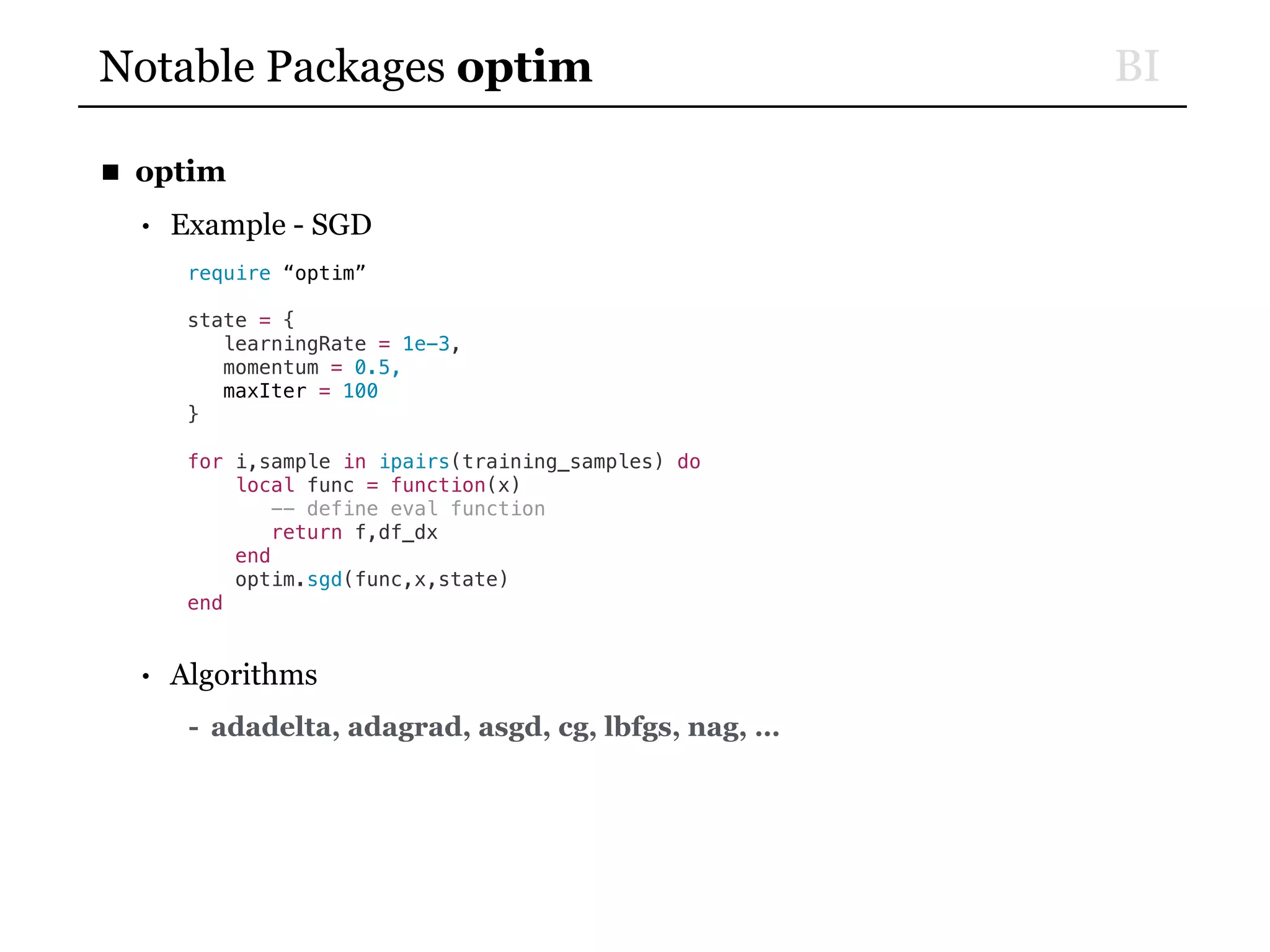
![BINotable Packages dp
■ Command-line Arguments
--[[command line arguments]]--
cmd = torch.CmdLine()
cmd:text()
cmd:text('Image Classification using MLP Training/Optimization')
cmd:text('Example:')
cmd:text('$> th neuralnetwork.lua --batchSize 128 --momentum 0.5')
cmd:text('Options:')
cmd:option('--learningRate', 0.1, 'learning rate at t=0')
cmd:option('--schedule', '{}', 'learning rate schedule')
cmd:option('--hiddenSize', '{200,200}', 'number of hidden units per layer')
⋮
cmd:option('--batchSize', 32, 'number of examples per batch')
cmd:option('--cuda', false, 'use CUDA')
cmd:option('--useDevice', 1, 'sets the device (GPU) to use')
cmd:option('--maxEpoch', 100, 'maximum number of epochs to run')
cmd:option('--dropout', false, 'apply dropout on hidden neurons')
cmd:option('--batchNorm', false, 'use batch normalization. dropout is mostly redundant with this')
cmd:option('--dataset', 'Mnist', 'which dataset to use : Mnist | NotMnist | Cifar10 | Cifar100')
cmd:option('--standardize', false, 'apply Standardize preprocessing')
cmd:option('--zca', false, 'apply Zero-Component Analysis whitening')
cmd:option('--progress', false, 'display progress bar')
cmd:option('--silent', false, 'dont print anything to stdout')
cmd:text()
opt = cmd:parse(arg or {})
opt.schedule = dp.returnString(opt.schedule)
opt.hiddenSize = dp.returnString(opt.hiddenSize)
if not opt.silent then
table.print(opt)
end](https://image.slidesharecdn.com/simplefastandscalabletorch7tutorial-150924024306-lva1-app6891/75/Simple-fast-and-scalable-torch7-tutorial-14-2048.jpg)
![BINotable Packages dp
■ Preprocess
--[[preprocessing]]--
local input_preprocess = {}
if opt.standardize then
table.insert(input_preprocess, dp.Standardize())
end
if opt.zca then
table.insert(input_preprocess, dp.ZCA())
end
if opt.lecunlcn then
table.insert(input_preprocess, dp.GCN())
table.insert(input_preprocess, dp.LeCunLCN{progress=true})
end
■ DataSource
--[[data]]--
if opt.dataset == 'Mnist' then
ds = dp.Mnist{input_preprocess = input_preprocess}
elseif opt.dataset == 'NotMnist' then
ds = dp.NotMnist{input_preprocess = input_preprocess}
elseif opt.dataset == 'Cifar10' then
ds = dp.Cifar10{input_preprocess = input_preprocess}
elseif opt.dataset == 'Cifar100' then
ds = dp.Cifar100{input_preprocess = input_preprocess}
else
error("Unknown Dataset")
end](https://image.slidesharecdn.com/simplefastandscalabletorch7tutorial-150924024306-lva1-app6891/75/Simple-fast-and-scalable-torch7-tutorial-15-2048.jpg)
![BINotable Packages dp
■ Model of Modules
--[[Model]]--
model = nn.Sequential()
model:add(nn.Convert(ds:ioShapes(), 'bf')) -- to batchSize x nFeature (also type converts)
-- hidden layers
inputSize = ds:featureSize()
for i,hiddenSize in ipairs(opt.hiddenSize) do
model:add(nn.Linear(inputSize, hiddenSize)) -- parameters
if opt.batchNorm then
model:add(nn.BatchNormalization(hiddenSize))
end
model:add(nn.Tanh())
if opt.dropout then
model:add(nn.Dropout())
end
inputSize = hiddenSize
end
-- output layer
model:add(nn.Linear(inputSize, #(ds:classes())))
model:add(nn.LogSoftMax())](https://image.slidesharecdn.com/simplefastandscalabletorch7tutorial-150924024306-lva1-app6891/75/Simple-fast-and-scalable-torch7-tutorial-16-2048.jpg)
![BINotable Packages dp
■ Propagator
--[[Propagators]]--
if opt.lrDecay == 'adaptive' then
ad = dp.AdaptiveDecay{max_wait = opt.maxWait, decay_factor=opt.decayFactor}
elseif opt.lrDecay == 'linear' then
opt.decayFactor = (opt.minLR - opt.learningRate)/opt.saturateEpoch
end
train = dp.Optimizer{
acc_update = opt.accUpdate, loss = nn.ModuleCriterion(nn.ClassNLLCriterion(), nil, nn.Convert()),
epoch_callback = function(model, report) -- called every epoch
-- learning rate decay
if report.epoch > 0 then
if opt.lrDecay == 'adaptive' then
opt.learningRate = opt.learningRate*ad.decay
ad.decay = 1
elseif opt.lrDecay == 'schedule' and opt.schedule[report.epoch] then
opt.learningRate = opt.schedule[report.epoch]
elseif opt.lrDecay == 'linear' then
opt.learningRate = opt.learningRate + opt.decayFactor
end
opt.learningRate = math.max(opt.minLR, opt.learningRate)
if not opt.silent then
print("learningRate", opt.learningRate)
end
end
end,
callback = function(model, report) -- called every batch
if opt.accUpdate then
model:accUpdateGradParameters(model.dpnn_input, model.output, opt.learningRate)
else
model:updateGradParameters(opt.momentum) -- affects gradParams
model:updateParameters(opt.learningRate) -- affects params
end
model:maxParamNorm(opt.maxOutNorm) -- affects params
model:zeroGradParameters() -- affects gradParams
end,
feedback = dp.Confusion(), sampler = dp.ShuffleSampler{batch_size = opt.batchSize}, progress = opt.progress
}
valid = dp.Evaluator{
feedback = dp.Confusion(), sampler = dp.Sampler{batch_size = opt.batchSize}
}
test = dp.Evaluator{
feedback = dp.Confusion(), sampler = dp.Sampler{batch_size = opt.batchSize}
}](https://image.slidesharecdn.com/simplefastandscalabletorch7tutorial-150924024306-lva1-app6891/75/Simple-fast-and-scalable-torch7-tutorial-17-2048.jpg)
![BINotable Packages dp
■ Experiment
--[[Experiment]]--
xp = dp.Experiment{
model = model,
optimizer = train,
validator = valid,
tester = test,
observer = {
dp.FileLogger(),
dp.EarlyStopper{
error_report = {'validator','feedback','confusion','accuracy'},
maximize = true,
max_epochs = opt.maxTries
}
},
random_seed = os.time(),
max_epoch = opt.maxEpoch
}](https://image.slidesharecdn.com/simplefastandscalabletorch7tutorial-150924024306-lva1-app6891/75/Simple-fast-and-scalable-torch7-tutorial-18-2048.jpg)
![BINotable Packages dp
■ Running the Experiment
--[[GPU or CPU]]--
if opt.cuda then
require 'cutorch'
require 'cunn'
cutorch.setDevice(opt.useDevice)
xp:cuda()
end
--[[Experiment]]--
xp:run(ds)
■ Loading the saved Experiment
require 'dp'
require 'cuda' -- if you used cmd-line argument --cuda
xp = torch.load("/home/nicholas/save/xps:1432747515:1.dat")
model = xp:model()
print(torch.type(model))
nn.Serial
model = model.module
print(torch.type(model))
nn.Sequential](https://image.slidesharecdn.com/simplefastandscalabletorch7tutorial-150924024306-lva1-app6891/75/Simple-fast-and-scalable-torch7-tutorial-19-2048.jpg)
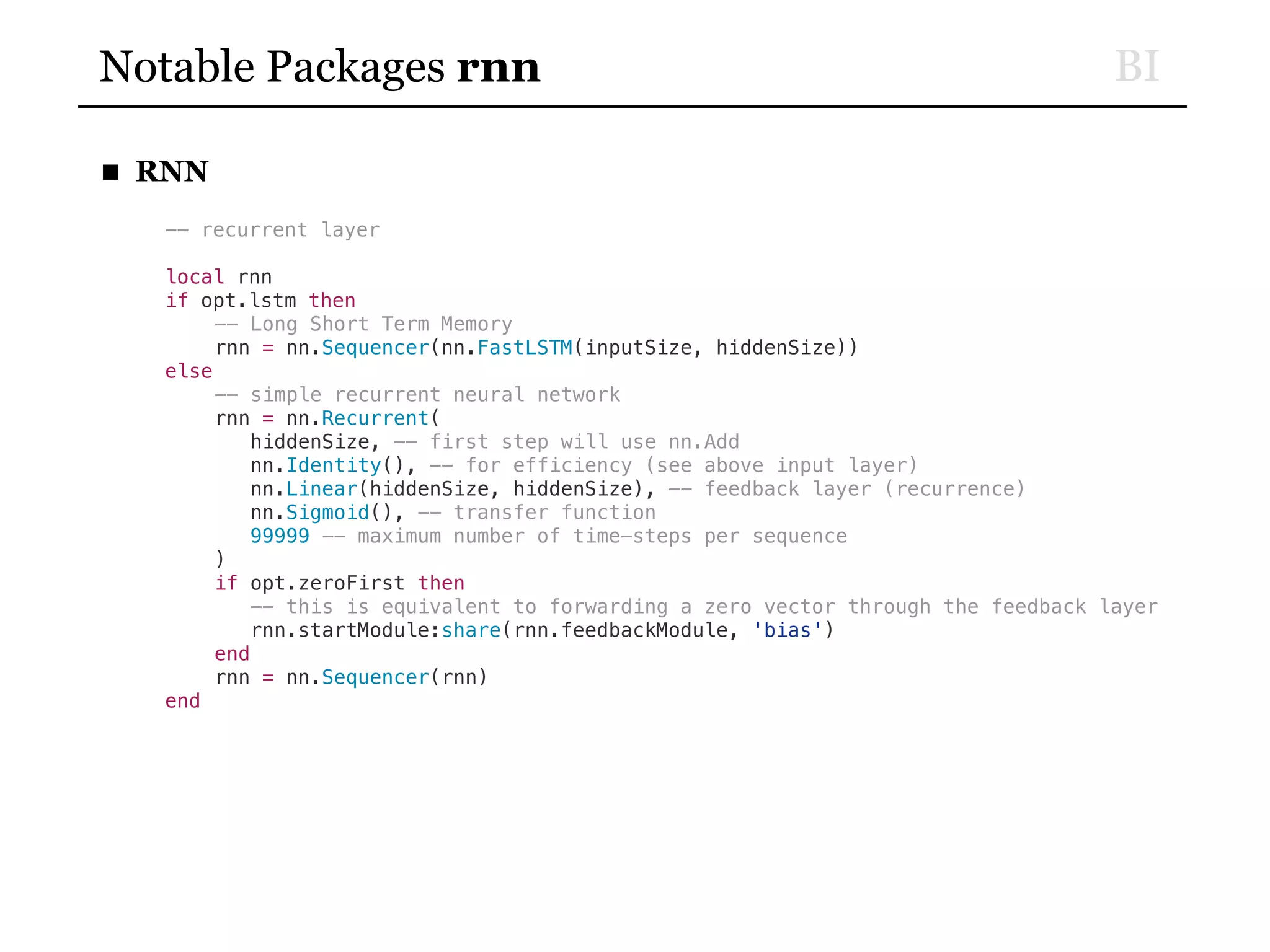
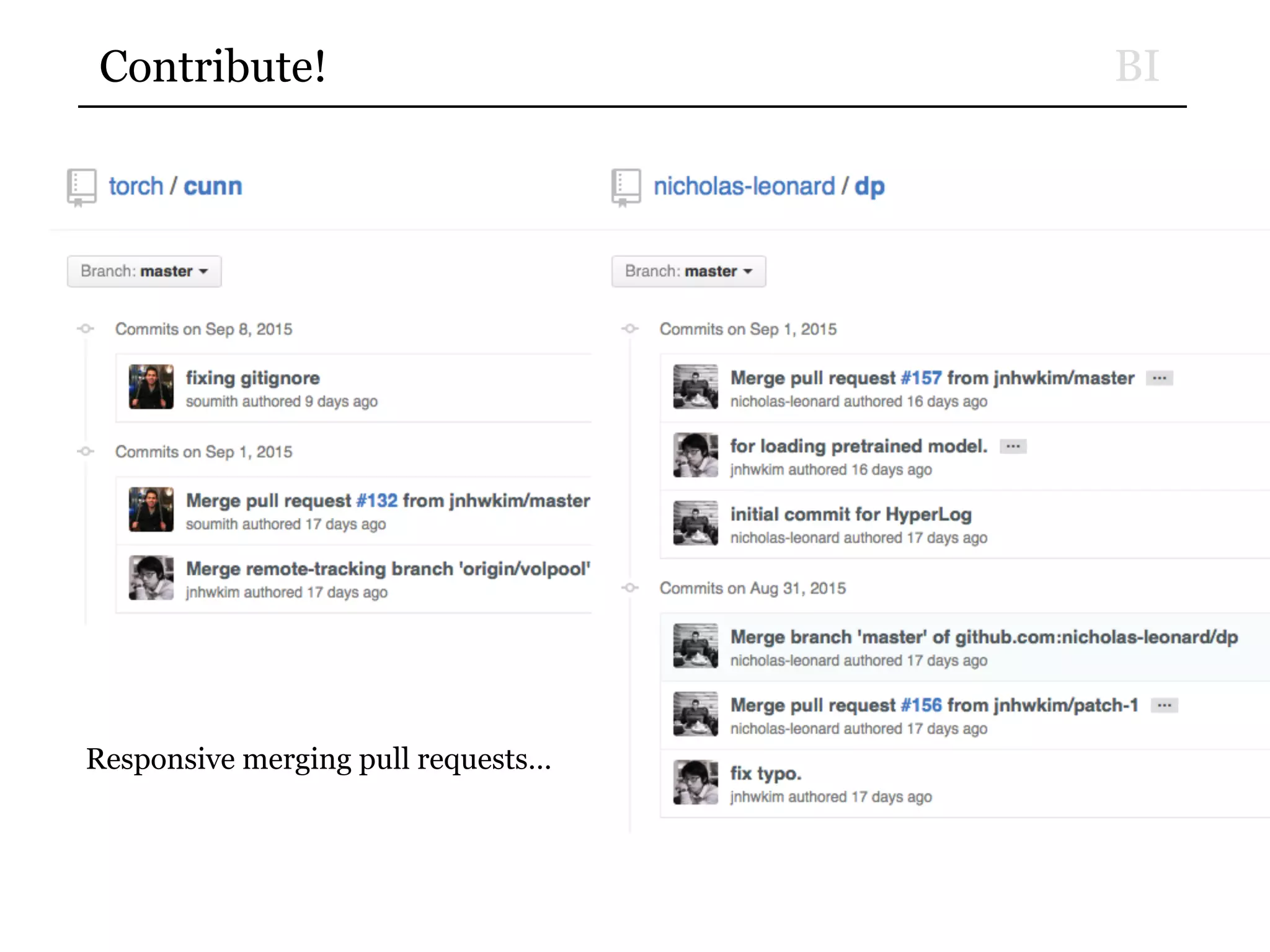
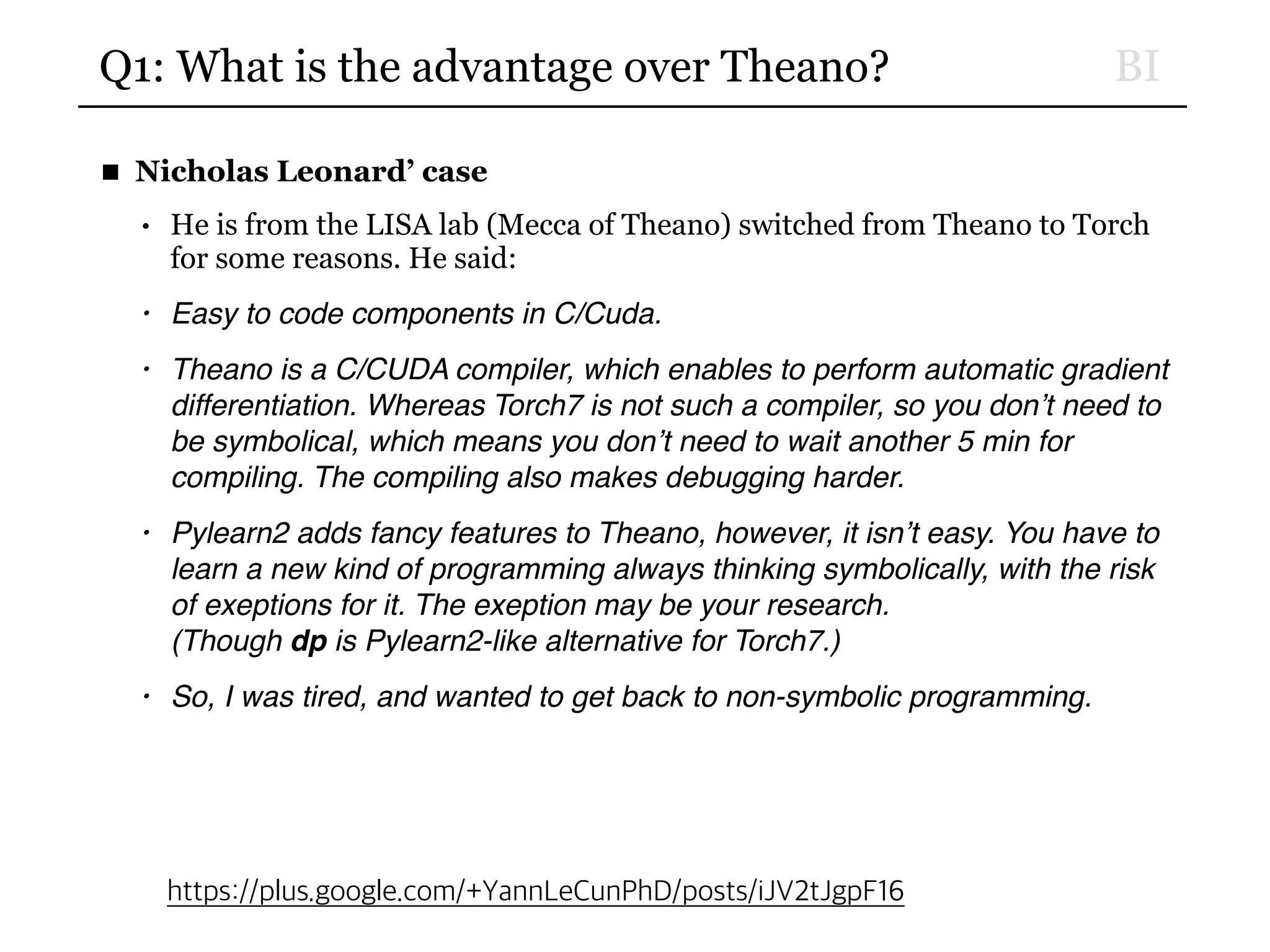

![BIQ2: Is the # of dimmensions unlimited?
■ Torch7 supports an unlimited multi-dimmensional Tensor matrix.
• The number of dimensions is unlimited that can be created using
LongStorage with more dimensions.
--- creation of a 4D-tensor 4x5x6x2
z = torch.Tensor(4,5,6,2)
--- for more dimensions, (here a 6D tensor) one can do:
s = torch.LongStorage(6)
--- assigning lengths for each dimension, not values
s[1] = 4; s[2] = 5; s[3] = 6; s[4] = 2; s[5] = 7; s[6] = 3;
x = torch.Tensor(s)
> x:nDimension()
6
> x:size()
4
5
6
2
7
3
[torch.LongStorage of size 6]](https://image.slidesharecdn.com/simplefastandscalabletorch7tutorial-150924024306-lva1-app6891/75/Simple-fast-and-scalable-torch7-tutorial-24-2048.jpg)
